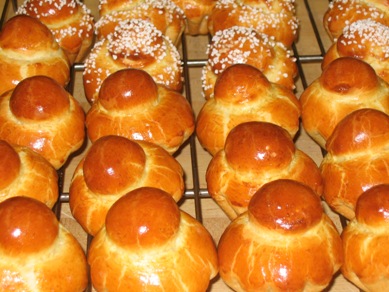Brioche and Beyond
27 February 2010By Mitch Stamm, CEPC
 By hiding the science in the pure joy of handling dough that has baked into pastries, you can increase students’ understanding and awareness of the baking process.
By hiding the science in the pure joy of handling dough that has baked into pastries, you can increase students’ understanding and awareness of the baking process.
Taking a lesson from parents who hide vegetables in other foods and desserts in order to train their children to appreciate them, instructors can do the same by hiding science in food. Many students find the science of baking dry and dull, yet they thrive when producing pastries. Rather than teaching science, why not teach food?
Brioche production is an excellent tool for engaging students in the properties and characteristics of ingredients and the principles and techniques of production. Brioche and its variations intersect the skill sets of bakers and pastry chefs with its bread-making technology and its inclusion of pastry ingredients. With sweet and savory applications, brioche is one of the most versatile yeasted products in any pasty or baking repertoire.
Flour selection is the first order of business. Hard, red, winter wheat with a protein level of approximately 12% will provide the appropriate amount of gluten-forming proteins necessary for developing the dough strength required to maintain the traditional shapes of this product. Glutenin, gliadin, elasticity, extensibility, tolerance and tenacity play important roles in dough development and handling.
Osmotolerant yeast resists the hygroscopic pull of sugar when it is used at higher levels. Brioche recipes include sugar at 12% to 14% of the weight of the flour.
Sugar tenderizes, provides sweetness (an ensuing discussion on taste vs. flavor can be inserted here), improves crust color (caramelization) and increases shelf life with its hygroscopic nature
Salt controls fermentation, tightens gluten, increases shelf life with its hygroscopic and anti-microbial properties and harmonizes all flavors.
Eggs provide the majority of if not all of the hydration in classic brioche production, usually in the amount of 50% to 60% of the weight of the flour (occasionally, up to 10% of the egg content is replaced with water and/or milk). It should be pointed out that while eggs are liquid, they are not all water. They contain 12% protein, 10% fats and emulsifiers, 2% various components such as sugars and ash, and only 76% moisture. Thus, 100 ounces of egg provides only 76 ounces of hydration. Eggs also provide richness and flavor to the final product. This is the perfect time to discuss the makeup of eggs, emulsification and even pH. (Egg white is one of the few ingredients in the bakery that is alkaline; baking soda and baker’s lye are others). Egg freshness, handling and sanitation can all be introduced.
Butter provides flavor and mouthfeel and, like all fats, improves shelf life, tenderizes and promotes the sensation of moistness. A brief study of butter-making could touch on the composition of milk and other interesting facts, such as 21 pounds of milk is required to make 1 pound of butter. An understanding of the temperature ranges of butter enables students to maximize the characteristics it provides to baked goods: Butter is most plastic at 60° to 70°; it is soft at 80; it has a melting point of 88°, with a final melting point of 94°.
The intensive mixing method is necessary due to the gluten-inhibiting effects of fats and sugars. This affords the instructor the opportunity to elaborate on the three main mixing methods for producing yeasted dough: short, improved and intensive and the unique characteristics each provides to the final product.
Cold liquids are used to offset the high friction factor associated with the intensive mixing method. This would allow the baker to obtain a 75° to 78° dough for optimum fermentation.
Many curricula introduce methodology and science prior to the actual production of baked goods. There is no sound argument for not including the scientific aspect of baking in course materials. With a strong understanding of fundamentals, students will achieve successful results at the bench and the oven. By hiding the science in the pure joy of handling dough that has baked into pastries which have delighted people for centuries, the instructor can lay a foundation for the students to increase their understanding and awareness of the baking process.
At the end of our students’ education, it’s not what they know; it’s what they understand.
Mitch Stamm is an associate instructor at Johnson & Wales University in Providence, R.I., where he teaches principles and techniques of bread-making.
